Cathay Pacific Airways (CX) celebrated the delivery of its first A350-900 aircraft – one of 22 on order for 2016 and 2017 – with a lavish event at Hong Kong International Airport last night.
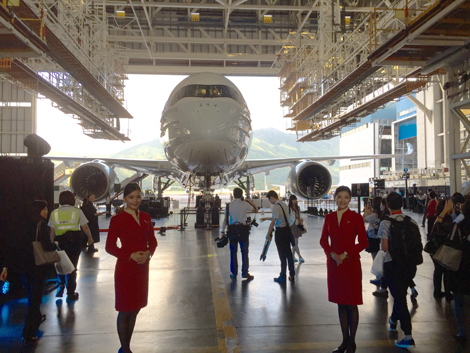 New A350 aircraft in the hangar at HKIA
The gleaming aircraft, on display for media, VIPs and select Marco Polo guests in a HAECO hangar, features all-new in-flight products and is set to begin its operational life today on the Manila route.
The Airbus A350 is a new-generation aircraft, built largely from carbon fibre and packed with engineering and technological innovations that increase its operational efficiency by 25 per cent.
We have written extensively on the A350 before, but in brief, its highlights include:
New A350 aircraft in the hangar at HKIA
The gleaming aircraft, on display for media, VIPs and select Marco Polo guests in a HAECO hangar, features all-new in-flight products and is set to begin its operational life today on the Manila route.
The Airbus A350 is a new-generation aircraft, built largely from carbon fibre and packed with engineering and technological innovations that increase its operational efficiency by 25 per cent.
We have written extensively on the A350 before, but in brief, its highlights include:
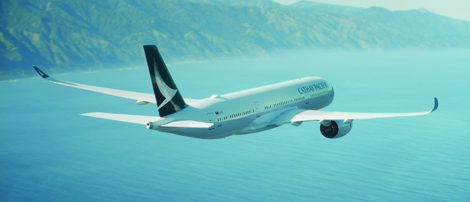 Distinctive A350 wingtips
“From an engineering point of view, this is like going from a double-decker bus to a high-performance sports car,” said Robert Taylor, CX’s head of the A350 project.
Within the cockpit, the A350’s pilots benefit from military aviation technology with a heads-up display, and onboard computers have been reduced by 50 per cent due to technological advancements.
CX’s A350 will be a paperless aircraft – it will no longer need to carry 70kg of charts and maps because this will be available electronically. In the passenger cabins more than 30 digital magazines (including Business Traveller Asia-Pacific) will be available to view on the seat-back screens.
“This is a commercial aircraft that is as environmentally friendly as you can get,” said Rupert Hogg, CX’s chief operational officer.
In a first for CX’s fleet, the A350 will offer wifi connectivity for passengers – once the plane reaches 10,000 feet you will be able to log on to the CX Network and get connected for US$9.95 per hour, US$12.95 for a short-haul pass or US$19.95 for a long-haul pass.
The A350-900 will seat 280 passengers in three classes: 38 in business class (1-2-1), 28 in premium economy (2-4-2) and 214 in economy (3-3-3).
The new business class and premium economy seats have been designed by Studio FA Porsche. The sculpted seat shell of business class has been kept, but seat pitch is up from 43 to 45 inches, with the lie-flat bed remaining at 75 inches long.
Distinctive A350 wingtips
“From an engineering point of view, this is like going from a double-decker bus to a high-performance sports car,” said Robert Taylor, CX’s head of the A350 project.
Within the cockpit, the A350’s pilots benefit from military aviation technology with a heads-up display, and onboard computers have been reduced by 50 per cent due to technological advancements.
CX’s A350 will be a paperless aircraft – it will no longer need to carry 70kg of charts and maps because this will be available electronically. In the passenger cabins more than 30 digital magazines (including Business Traveller Asia-Pacific) will be available to view on the seat-back screens.
“This is a commercial aircraft that is as environmentally friendly as you can get,” said Rupert Hogg, CX’s chief operational officer.
In a first for CX’s fleet, the A350 will offer wifi connectivity for passengers – once the plane reaches 10,000 feet you will be able to log on to the CX Network and get connected for US$9.95 per hour, US$12.95 for a short-haul pass or US$19.95 for a long-haul pass.
The A350-900 will seat 280 passengers in three classes: 38 in business class (1-2-1), 28 in premium economy (2-4-2) and 214 in economy (3-3-3).
The new business class and premium economy seats have been designed by Studio FA Porsche. The sculpted seat shell of business class has been kept, but seat pitch is up from 43 to 45 inches, with the lie-flat bed remaining at 75 inches long.
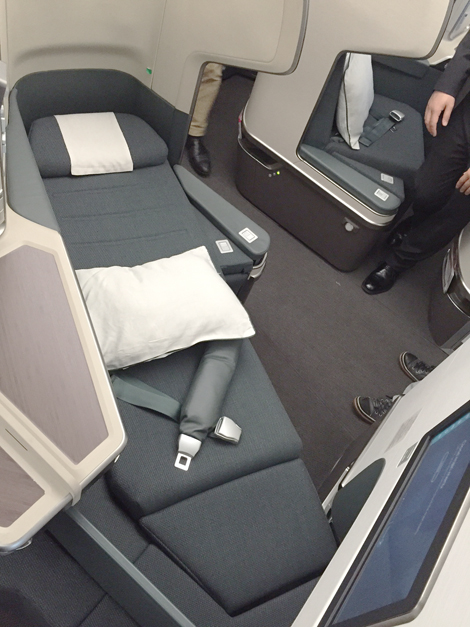 Lie-flat business class seat
The ottoman and side bench above a storage bin are padded and become part of the bed area, meaning more space for feet and knees when sleeping on your side – a useful feature. Also very useful is a “Do not Disturb” and “Wake-up Call” feature, while the personal TV is now up to 18.5 inches in size.
Lie-flat business class seat
The ottoman and side bench above a storage bin are padded and become part of the bed area, meaning more space for feet and knees when sleeping on your side – a useful feature. Also very useful is a “Do not Disturb” and “Wake-up Call” feature, while the personal TV is now up to 18.5 inches in size.
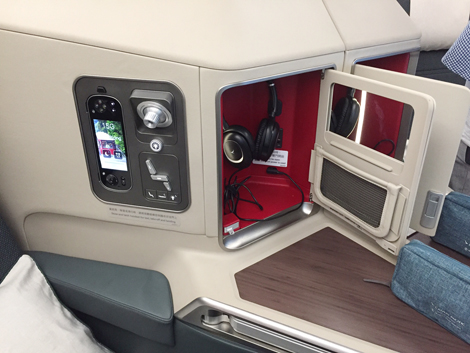 Remote and seat control on a side panel, with noise-cancelling headphones tucked away
Premium economy seats have increased to 40 inches of seat pitch, nine inches of recline and the TV screen is up to 12.1 inches.
Remote and seat control on a side panel, with noise-cancelling headphones tucked away
Premium economy seats have increased to 40 inches of seat pitch, nine inches of recline and the TV screen is up to 12.1 inches.
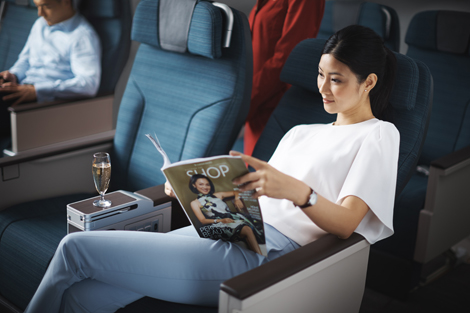 Premium economy product
Each seat gets a full-length integrated leg rest, and a nice touch are the retractable armrests in aisle seats to enhance space flexibility, meaning you can swing your legs to the side to allow a passenger out into the aisle rather than standing up. Personal reading lights at shoulder level are also well thought out, movable and dimmable so as to minimise disturbance for other passengers.
Common to seats in premium economy and economy are tablet holders – small drop-down shelves below the TVs on which you can place your iPad or other device should you wish to watch your own content. The IFE has been upgraded throughout too, with a more tablet-like user interface on the screens and a host of extra content.
Premium economy product
Each seat gets a full-length integrated leg rest, and a nice touch are the retractable armrests in aisle seats to enhance space flexibility, meaning you can swing your legs to the side to allow a passenger out into the aisle rather than standing up. Personal reading lights at shoulder level are also well thought out, movable and dimmable so as to minimise disturbance for other passengers.
Common to seats in premium economy and economy are tablet holders – small drop-down shelves below the TVs on which you can place your iPad or other device should you wish to watch your own content. The IFE has been upgraded throughout too, with a more tablet-like user interface on the screens and a host of extra content.
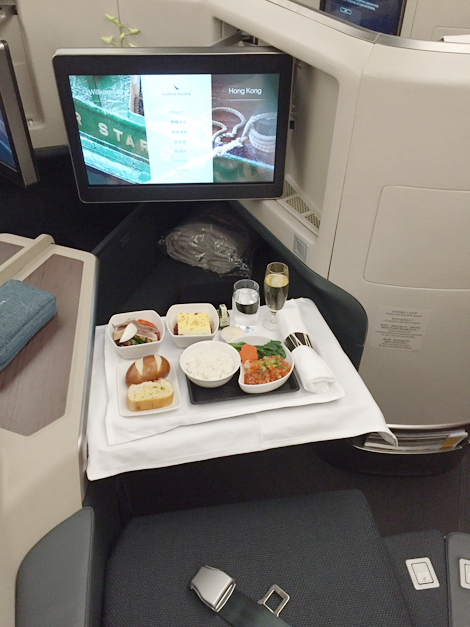 In-flight entertainment screen with F&B sample
“We’ve spent the last three or four years sweating the details on our new suite of in-flight products, constantly thinking about the things, large or small, that make a difference to you when you travel,” said Hogg.
The new seat products are likely to be retrofitted to CX’s B777-300 aircraft, and the software upgrades will eventually be mirrored across the whole fleet.
“The A350 will make a positive difference to our customers, for the growth of our operations, for the environment and for Hong Kong,” concluded Hogg.
After familiarisation flights, the A350 will start operating a new Hong Kong-London Gatwick route on September 2 this year, with Dusseldorf the next European destination scheduled to receive the new-gen plane. As more of the 22 A350s on order are delivered, Australia and New Zealand are likely to be added to its repertoire, although Europe is the primary region of focus.
From 2018 onwards, CX also has 26 A350-1000s on order – the larger aircraft has an even greater payload and distance capability.
For more information, visit cathaypacific.com
Jeremy Tredinnick
In-flight entertainment screen with F&B sample
“We’ve spent the last three or four years sweating the details on our new suite of in-flight products, constantly thinking about the things, large or small, that make a difference to you when you travel,” said Hogg.
The new seat products are likely to be retrofitted to CX’s B777-300 aircraft, and the software upgrades will eventually be mirrored across the whole fleet.
“The A350 will make a positive difference to our customers, for the growth of our operations, for the environment and for Hong Kong,” concluded Hogg.
After familiarisation flights, the A350 will start operating a new Hong Kong-London Gatwick route on September 2 this year, with Dusseldorf the next European destination scheduled to receive the new-gen plane. As more of the 22 A350s on order are delivered, Australia and New Zealand are likely to be added to its repertoire, although Europe is the primary region of focus.
From 2018 onwards, CX also has 26 A350-1000s on order – the larger aircraft has an even greater payload and distance capability.
For more information, visit cathaypacific.com
Jeremy Tredinnick
 New A350 aircraft in the hangar at HKIA
The gleaming aircraft, on display for media, VIPs and select Marco Polo guests in a HAECO hangar, features all-new in-flight products and is set to begin its operational life today on the Manila route.
The Airbus A350 is a new-generation aircraft, built largely from carbon fibre and packed with engineering and technological innovations that increase its operational efficiency by 25 per cent.
We have written extensively on the A350 before, but in brief, its highlights include:
New A350 aircraft in the hangar at HKIA
The gleaming aircraft, on display for media, VIPs and select Marco Polo guests in a HAECO hangar, features all-new in-flight products and is set to begin its operational life today on the Manila route.
The Airbus A350 is a new-generation aircraft, built largely from carbon fibre and packed with engineering and technological innovations that increase its operational efficiency by 25 per cent.
We have written extensively on the A350 before, but in brief, its highlights include:
- A quieter environment, both inside and outside the plane
- Vertical sidewalls for more shoulder space
- Larger panoramic windows due to stronger carbon fibre construction
- LED mood lighting that can simulate sunset/sunrise and all phases in between
- Lower cabin pressure that equates to a 6,000-foot (1,829-metre) altitude rather than most planes’ 8,000-foot (2,438-metre) atmospheric environment
 Distinctive A350 wingtips
“From an engineering point of view, this is like going from a double-decker bus to a high-performance sports car,” said Robert Taylor, CX’s head of the A350 project.
Within the cockpit, the A350’s pilots benefit from military aviation technology with a heads-up display, and onboard computers have been reduced by 50 per cent due to technological advancements.
CX’s A350 will be a paperless aircraft – it will no longer need to carry 70kg of charts and maps because this will be available electronically. In the passenger cabins more than 30 digital magazines (including Business Traveller Asia-Pacific) will be available to view on the seat-back screens.
“This is a commercial aircraft that is as environmentally friendly as you can get,” said Rupert Hogg, CX’s chief operational officer.
In a first for CX’s fleet, the A350 will offer wifi connectivity for passengers – once the plane reaches 10,000 feet you will be able to log on to the CX Network and get connected for US$9.95 per hour, US$12.95 for a short-haul pass or US$19.95 for a long-haul pass.
The A350-900 will seat 280 passengers in three classes: 38 in business class (1-2-1), 28 in premium economy (2-4-2) and 214 in economy (3-3-3).
The new business class and premium economy seats have been designed by Studio FA Porsche. The sculpted seat shell of business class has been kept, but seat pitch is up from 43 to 45 inches, with the lie-flat bed remaining at 75 inches long.
Distinctive A350 wingtips
“From an engineering point of view, this is like going from a double-decker bus to a high-performance sports car,” said Robert Taylor, CX’s head of the A350 project.
Within the cockpit, the A350’s pilots benefit from military aviation technology with a heads-up display, and onboard computers have been reduced by 50 per cent due to technological advancements.
CX’s A350 will be a paperless aircraft – it will no longer need to carry 70kg of charts and maps because this will be available electronically. In the passenger cabins more than 30 digital magazines (including Business Traveller Asia-Pacific) will be available to view on the seat-back screens.
“This is a commercial aircraft that is as environmentally friendly as you can get,” said Rupert Hogg, CX’s chief operational officer.
In a first for CX’s fleet, the A350 will offer wifi connectivity for passengers – once the plane reaches 10,000 feet you will be able to log on to the CX Network and get connected for US$9.95 per hour, US$12.95 for a short-haul pass or US$19.95 for a long-haul pass.
The A350-900 will seat 280 passengers in three classes: 38 in business class (1-2-1), 28 in premium economy (2-4-2) and 214 in economy (3-3-3).
The new business class and premium economy seats have been designed by Studio FA Porsche. The sculpted seat shell of business class has been kept, but seat pitch is up from 43 to 45 inches, with the lie-flat bed remaining at 75 inches long.
 Lie-flat business class seat
The ottoman and side bench above a storage bin are padded and become part of the bed area, meaning more space for feet and knees when sleeping on your side – a useful feature. Also very useful is a “Do not Disturb” and “Wake-up Call” feature, while the personal TV is now up to 18.5 inches in size.
Lie-flat business class seat
The ottoman and side bench above a storage bin are padded and become part of the bed area, meaning more space for feet and knees when sleeping on your side – a useful feature. Also very useful is a “Do not Disturb” and “Wake-up Call” feature, while the personal TV is now up to 18.5 inches in size.
 Remote and seat control on a side panel, with noise-cancelling headphones tucked away
Premium economy seats have increased to 40 inches of seat pitch, nine inches of recline and the TV screen is up to 12.1 inches.
Remote and seat control on a side panel, with noise-cancelling headphones tucked away
Premium economy seats have increased to 40 inches of seat pitch, nine inches of recline and the TV screen is up to 12.1 inches.
 Premium economy product
Each seat gets a full-length integrated leg rest, and a nice touch are the retractable armrests in aisle seats to enhance space flexibility, meaning you can swing your legs to the side to allow a passenger out into the aisle rather than standing up. Personal reading lights at shoulder level are also well thought out, movable and dimmable so as to minimise disturbance for other passengers.
Common to seats in premium economy and economy are tablet holders – small drop-down shelves below the TVs on which you can place your iPad or other device should you wish to watch your own content. The IFE has been upgraded throughout too, with a more tablet-like user interface on the screens and a host of extra content.
Premium economy product
Each seat gets a full-length integrated leg rest, and a nice touch are the retractable armrests in aisle seats to enhance space flexibility, meaning you can swing your legs to the side to allow a passenger out into the aisle rather than standing up. Personal reading lights at shoulder level are also well thought out, movable and dimmable so as to minimise disturbance for other passengers.
Common to seats in premium economy and economy are tablet holders – small drop-down shelves below the TVs on which you can place your iPad or other device should you wish to watch your own content. The IFE has been upgraded throughout too, with a more tablet-like user interface on the screens and a host of extra content.
 In-flight entertainment screen with F&B sample
“We’ve spent the last three or four years sweating the details on our new suite of in-flight products, constantly thinking about the things, large or small, that make a difference to you when you travel,” said Hogg.
The new seat products are likely to be retrofitted to CX’s B777-300 aircraft, and the software upgrades will eventually be mirrored across the whole fleet.
“The A350 will make a positive difference to our customers, for the growth of our operations, for the environment and for Hong Kong,” concluded Hogg.
After familiarisation flights, the A350 will start operating a new Hong Kong-London Gatwick route on September 2 this year, with Dusseldorf the next European destination scheduled to receive the new-gen plane. As more of the 22 A350s on order are delivered, Australia and New Zealand are likely to be added to its repertoire, although Europe is the primary region of focus.
From 2018 onwards, CX also has 26 A350-1000s on order – the larger aircraft has an even greater payload and distance capability.
For more information, visit cathaypacific.com
Jeremy Tredinnick
In-flight entertainment screen with F&B sample
“We’ve spent the last three or four years sweating the details on our new suite of in-flight products, constantly thinking about the things, large or small, that make a difference to you when you travel,” said Hogg.
The new seat products are likely to be retrofitted to CX’s B777-300 aircraft, and the software upgrades will eventually be mirrored across the whole fleet.
“The A350 will make a positive difference to our customers, for the growth of our operations, for the environment and for Hong Kong,” concluded Hogg.
After familiarisation flights, the A350 will start operating a new Hong Kong-London Gatwick route on September 2 this year, with Dusseldorf the next European destination scheduled to receive the new-gen plane. As more of the 22 A350s on order are delivered, Australia and New Zealand are likely to be added to its repertoire, although Europe is the primary region of focus.
From 2018 onwards, CX also has 26 A350-1000s on order – the larger aircraft has an even greater payload and distance capability.
For more information, visit cathaypacific.com
Jeremy Tredinnick 







